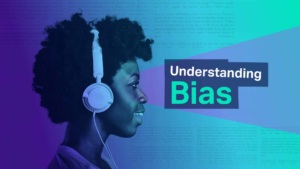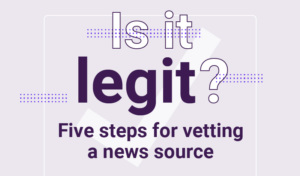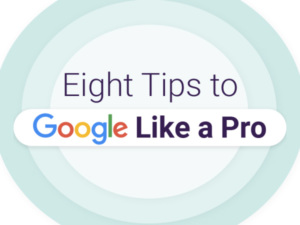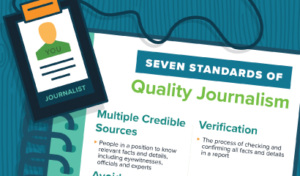In brief: News media bias
People across the political spectrum often feel that “the media” is biased against their beliefs and values. But what counts as bias in news? And why do so few people feel that news coverage is slanted in their favor?
This infographic provides six tips to help you think clearly about this nuanced and important topic:
- Differentiate news from opinion: News reports — also called “straight news” or “hard news” — should be as free of bias as possible. But remember that opinion columns, editorials and op-eds are not produced to be impartial. They’re supposed to express an opinion.
- Think about bias as a spectrum: It’s helpful to think about bias in news as a spectrum (more or less biased) rather than a binary (biased and unbiased).
- Ask yourself: Compared with what? When you encounter allegations of bias in news, keep these questions in mind: Biased compared with what? Can I point to an example of information that is fairer, more accurate and more impartial?
- Recognize your own biases: Our own preconceptions can cause us to misperceive elements of news coverage, make assumptions about the motivations of journalists, or diligently search for ways to dismiss coverage as “biased” if it challenges our beliefs.
- Be wary of media bias charts and rating: Bias charts and rating systems seem to provide an easy way to assess bias in news, but they often contain startling shortcomings.
- Think about bias in terms of types and forms: Break through the hyperbole and political rhetoric around the issue of bias by testing your initial perceptions. What type of bias do you think you’re seeing? And what form do you see it taking in coverage?
6 things to know about AI
Artificial intelligence technology is not new, but dramatic advances in generative AI have captured the world’s attention and are transforming the information landscape.
This infographic provides an overview of how this technology works and offers six news literacy takeaways to keep in mind as these tools evolve:
- Generative AI tools are not objective: They are subject to the biases of the humans who make them, and any biases in the training data may show up when they are used.
- . . .or reliably factual: AI tools might feel authoritative and credible, but the responses they generate are routinely riddled with inaccuracies.
- It’s not all bad: AI tools also have tremendous upsides. (For example, they can boost scientific research and make complicated or specialized tasks more accessible, like writing computer code or building websites.)
- Content is easier than ever to create — and fake: AI chatbots and image generators produce text and visuals at an unprecedented scale — and have the potential to supercharge the spread of misinformation. Be ready to encounter even more information with less transparency about its origin.
- It signals a change in the nature of evidence: The rise of more convincing photos and videos means that determining the source and context for visuals is often more important than hunting for visual clues of authenticity. Any viral image you can’t verify through a reliable source — using a reverse image search, for example — should be approached with skepticism.
- Reputable sources matter more than ever: Credible sources follow processes to verify information before sharing it, and this should translate into higher levels of trust.
Don’t let AI technology undermine your willingness to trust anything you see and hear. Just be careful about what you accept as authentic.
Breaking news checklist
When big news breaks, it can be hard to cut through the noise and find accurate information. Misinformation thrives during times of war, natural disasters and upheaval — and bad actors often spread falsehoods for cheap engagement on social media.
This infographic offers six best practices to help you navigate fast-moving stories:
- Mind the gap: Keep in mind that there’s often a gap between what the public wants to know and the verified information available. Unconfirmed or completely bogus content often rushes in to fill that gap.
- Beware bad actors: Remember that bad actors often capitalize on breaking news situations to spread falsehoods for easy likes and shares.
- Do a quick search: This is often your best defense against misinformation.
- Look for evidence: Claims that make bold assertions but provide no links or other evidence should always be approached with caution.
- Seek credible sources: Be intentional about looking for credible news and not relying on social media algorithms to bring you updates.
- Practice patience: Quality journalism and verification take time. Be ready to follow news developments over time.
Remember: Early details in news reports may turn out to be incorrect, and it might take days or even weeks to untangle initial accounts in a major story. The last thing you want to do is add to the fog of confusion by sharing an unverified post or visual. Slowing down and following these tips can help keep you anchored as the story continues to unfold.
Levels of scientific evidence
For those of us whose memories of science classes are fuzzy at best, the credibility of “evidence” backing up information we encounter online can be difficult to discern. It is easy to mistake weak evidence for strong evidence. Bad actors can exploit this unfamiliarity to trick us into believing mis- and disinformation. That’s why we need to recognize that all evidence is not created equal.
 News reports and opinion pieces about scientific topics might cite a mix of different kinds of evidence so you will need to understand those types, including expert opinions, lab findings and research studies. We created this infographic with Dr. Katrine Wallace (Dr. Kat), an epidemiologist and assistant professor at the University of Illinois at Chicago, to help you determine the quality of the evidence presented to support a claim. Refer to the pyramid to evaluate the quality of evidence of a claim you encounter that’s a bit of a head-scratcher.
News reports and opinion pieces about scientific topics might cite a mix of different kinds of evidence so you will need to understand those types, including expert opinions, lab findings and research studies. We created this infographic with Dr. Katrine Wallace (Dr. Kat), an epidemiologist and assistant professor at the University of Illinois at Chicago, to help you determine the quality of the evidence presented to support a claim. Refer to the pyramid to evaluate the quality of evidence of a claim you encounter that’s a bit of a head-scratcher.
Click here to download the infographic (PDF).
What is news?
How would you define news? Chances are we all have different ideas about what makes something newsworthy, and we might wonder why some topics or events that interest us don’t make the headlines.
 Reporters, editors and other newsroom leaders constantly filter information to determine what is most important and interesting to their communities when deciding what to cover and how prominently to feature the material. Editors and reporters put a lot of thought — and meeting time — into deciding what is news. Many factors come into play — including staff, space, mix of content, community representation and more.
Reporters, editors and other newsroom leaders constantly filter information to determine what is most important and interesting to their communities when deciding what to cover and how prominently to feature the material. Editors and reporters put a lot of thought — and meeting time — into deciding what is news. Many factors come into play — including staff, space, mix of content, community representation and more.
This straightforward poster is a reminder of the basic factors that make something newsworthy. And if you witness or are aware of something in your community that meets these criteria, call in a tip to your local newspaper, TV or radio station.
Click here to download the infographic (PDF).
Understanding bias
Bias is one of the most controversial and important subjects in news literacy. People frequently perceive bias in news coverage, and accusations of bias are common in a wide variety of discussions and contexts.
 Our own perspectives, values and beliefs may lead us to assume that bias exists, especially if we have a strong opinion about the topic. This can result in confirmation bias, which is the tendency to quickly embrace information that affirms what we already think and feel and to unfairly dismiss or criticize information that complicates or contradicts those thoughts and feelings. Biases are baked into how we see and understand the world, although we often fail to notice them.
Our own perspectives, values and beliefs may lead us to assume that bias exists, especially if we have a strong opinion about the topic. This can result in confirmation bias, which is the tendency to quickly embrace information that affirms what we already think and feel and to unfairly dismiss or criticize information that complicates or contradicts those thoughts and feelings. Biases are baked into how we see and understand the world, although we often fail to notice them.
Productive conversations about bias require specificity and nuance — and less emotion. This infographic can help you recognize different types of bias (confirmation, partisan, etc.) and the forms it can take (flawed sourcing, story selection, and more). Then you’ll be able to check your own biases as you consume and share news and other content.
Click here to download the infographic (PDF).
Is it legit? Five steps for vetting a news source
Many sources compete for attention online, including partisan blogs and bogus sites posing as legitimate news organizations. It can be tough to know what information to trust. So, what does “credibility” look like, and how can you recognize it?
 With our partner, SmartNews, a news app for mobile devices, we’ve developed five steps for vetting news sources. Use this to cut through the noise and learn how to evaluate sources for signs of credibility. Remember: Credible sources aren’t perfect, but information from them is much more likely to be accurate. And when they are wrong, they should be transparent about identifying and correcting errors.
With our partner, SmartNews, a news app for mobile devices, we’ve developed five steps for vetting news sources. Use this to cut through the noise and learn how to evaluate sources for signs of credibility. Remember: Credible sources aren’t perfect, but information from them is much more likely to be accurate. And when they are wrong, they should be transparent about identifying and correcting errors.
And check out this quiz to put your source-vetting skills to the test!
Click here to download the infographic (PDF).
Eight tips to Google like a pro
The internet is inconceivably large. Sometimes it’s easy to find the information you need, but often trying to find something specific can be overwhelming. To help you find credible information and sources with ease, we partnered with disinformation research expert Cindy Otis — author of True or False: A CIA Analyst’s Guide to Spotting Fake News — to bring you eight tips that can help you improve your search results and zero in on what you’re looking for more quickly.
 These advanced searching skills can help you work your way back to the original source of specific claims, quotes, photos and videos — a critical step in fact-checking things you’re unsure about online. This infographic features hyperlinked example searches that demonstrate exactly how your results will look when you apply our tips. Effective searching is also about eliminating results that are irrelevant or untrustworthy. Implementing these small tweaks to your online searches can make a big difference.
These advanced searching skills can help you work your way back to the original source of specific claims, quotes, photos and videos — a critical step in fact-checking things you’re unsure about online. This infographic features hyperlinked example searches that demonstrate exactly how your results will look when you apply our tips. Effective searching is also about eliminating results that are irrelevant or untrustworthy. Implementing these small tweaks to your online searches can make a big difference.
Click here to download the infographic (PDF).
Seven standards of quality journalism
The standards and practices of quality journalism are complex, numerous and dynamic, and implemented differently depending on the journalist, news organization, circumstances or type of published work. See a trend here? Practicing journalism is complicated and nuanced. Still, the purpose behind the standards is the same: to produce the most accurate, fair and useful information possible.
 Truthfulness, transparency, eliminating bias and assuring coverage is fair and complete are some of the goals of these standards. Recognizing and understanding the standards of quality journalism helps you evaluate the credibility of the information you encounter daily and, in some cases, respond to it critically. The seven primary standards of quality journalism and their descriptions are included in the poster linked below.
Truthfulness, transparency, eliminating bias and assuring coverage is fair and complete are some of the goals of these standards. Recognizing and understanding the standards of quality journalism helps you evaluate the credibility of the information you encounter daily and, in some cases, respond to it critically. The seven primary standards of quality journalism and their descriptions are included in the poster linked below.
Click here to download the infographic (PDF).
In brief: Misinformation
Few problems with our information environment are more pressing or prominent than the proliferation of misinformation online. False and misleading content is often designed to target our emotions and exploit our most deeply held beliefs and values to bypass our critical, rational thought processes.
But thinking and learning about misinformation can be challenging. Partisans lob strategic accusations of “fake news” at ideas they disagree with. Social media platforms often fail to enforce their own policies against misinformation. Bad actors create and purposefully amplify disinformation for many reasons, political or financial gain or to simply to cause social division.
This infographic helps you get your bearings in the misinformation landscape. Why do people share misinformation? What is the difference between misinformation and disinformation? What are some of the different types of misinformation people regularly encounter online? What are some “red flag” phrases and other signs of dubious content that can help people recognize when to remain skeptical and proceed with caution? Misinformation changes rapidly, attaching itself to current events and issues that that are part of the national conversation. However, many of the strategies remain the same and can become recognizable with practice.
Click here to download the infographic (PDF).
How to speak up without starting a showdown
Misinformation is always problematic, but when it appears alongside pet photos and family updates on social media, it can be especially frustrating. It’s one thing if a stranger spreads falsehoods online or spouts conspiracy theories in a casual, in-person setting. But what should we do when we see misinformation shared by family and friends?
Stepping into the role of fact-checker when it comes to loved ones can be tricky and can stir strong emotions. To keep conversations productive whether on your screen or your screened-in porch, it’s essential to be prepared.
While every scenario is different, following some general best practices can help keep the conversation civil and make the interaction worthwhile. Use these six tips — with some helpful phrases for getting started — as a guide on how to speak up without starting a showdown. It may not be easy, but talking to loved ones about false or misleading content can help them think twice about the information they take at face value or share on their social media channels.